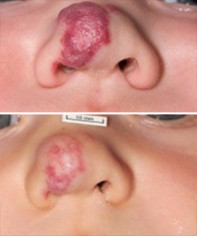Propranolol: a promising new treatment for infantile haemangioma
Infantile haemangiomas (IHs) are the most common vascular tumours of infancy, affecting 5 to 10% of the population. They occur predominantly in Caucasian children; there is a female predominance. The lesions have a predictable natural history of rapid growth during early infancy (over several months), followed by slower growth and gradual involution (over several years). Regression is complete in 50% of 5-year-old and 90% of 9-year-old patients.
The majority of IHs require no treatment and undergo spontaneous regression over time. However, spontaneous involution is no guarantee of a satisfactory cosmetic result. IHs in certain locations (eye, nasal tip, mouth and airway) may impair vital functions or cause disfigurement, requiring prompt intervention. Large, segmental or multifocal lesions pose systemic complications, and the local complication of painful ulceration can lead to scarring. Approximately 10% of children require treatment for IHs because of life-threatening locations, local complications, or cosmetic/functional risks.

